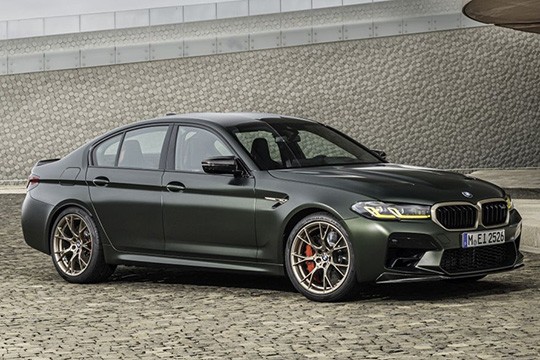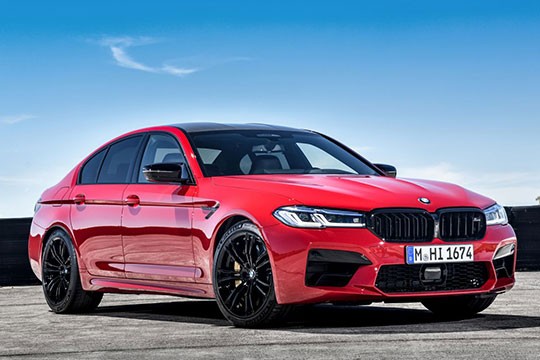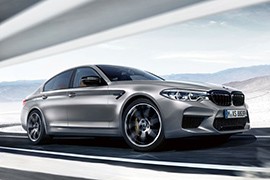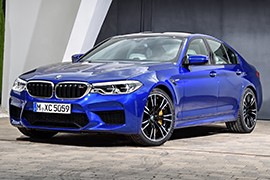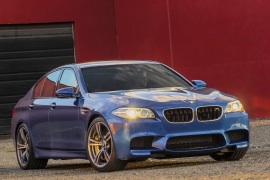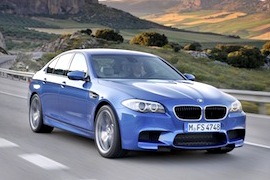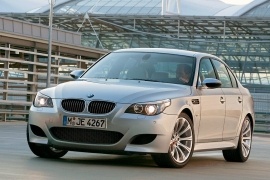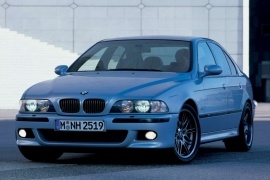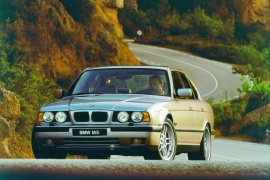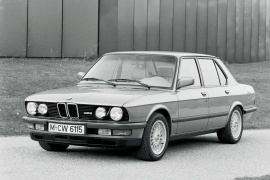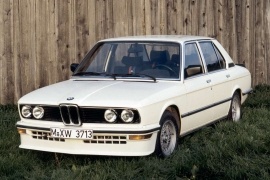BMW M5 Models/Series Timeline, Specifications & Photos
First production year: 1979
Engines: Gasoline
The 2021 BMW M5 CS was the swansong for the F90 generation, and it was the wildest card in the pack, providing customers with a four-door sedan that could compete against proper sports cars, and beat them.
Almost forty years have passed since BMW introduced the first generation of the 5 Series in 1972, and the German automaker has improved this lineup constantly. However, the M5 F90 was the first to get not one but two upgrades over its short production run. So, while the M5 was for those who wanted a luxurious, go-fast car and the M5 Competition was for those craving a go-fast elegant vehicle, the 2021 M5 CS was for those who really wanted a four-door, four-seat vehicle that could breach into the supercar territory thanks to its performance. But the M5 CS was not just about power. It provided just ten ponies more than the M5 Competition. It was about look, suspension, weight reduction, and exclusivity.
At the front, the M5 CS instantly grabbed attention thanks to its golden rim of the kidney grille and the yellowish L-shaped daytime running lights. These were specific for the CS and unavailable for the rest of the range. Furthermore, this special version came standard with laser headlights. At the same time, the lower bumper sported a new design for the side scoops, while a honeycomb mesh adorned the lower air intake. As a last detail, BMW installed a carbon fiber lip spoiler under the apron. The M5 CS also boasted a carbon fiber hood fitted with vents that helped to cool the engine.
The car sat lower to the ground from its profile than the regular M5 and featured unique-looking gold alloy wheels. Furthermore, the door mirror caps were made from carbon fiber as well. Through them, bystanders could see the 400 mm (15.7-inch) carbon ceramic brake discs fitted with six-piston gold or red caliper, depending on the option. The car sat lower to the ground than the M5 Competition, and it featured a suspension carried over from the BMW M8. Finally, at the back, the automaker placed a carbon fiber spoiler on the trunk’s lid. The same lightweight material was used to create the diffuser that was placed under the bumper.
Inside, the automaker installed four sports seats. Those from the front were separated by the narrow center console that housed the iDrive controller and the onboard computer. Fronting the driver was a fully digital instrument panel, while atop the center stack was a touchscreen for the infotainment system. Out back, the M5 CS provided enough legroom and headroom for two adults, but the middle row was deleted. To make the car lighter, BMW installed a carbon fiber roof, so a panoramic glass or a sunroof was out of the question. Additional carbon fiber trims and Alcantara decorations adorned the vehicle’s interior.
Under its skin, the M5 CS concealed the suspension carried over from the M8 GT vehicle, which made it more planted to the road. The engine was the same 4.4-liter V8 as the rest of the M5 siblings, albeit it developed 635 PS (626 hp). BMW paired it with an eight-speed automatic transmission that sent the power in all corners.
BMW refreshed the seventh generation of the 5 Series in 2020, and the M5 Competition also went through some styling and performance updates, making the vehicle more desirable to the brand’s fans.
The seventh generation of the 5 Series, known as the G30 in BMW’s naming system, was introduced in 2017. Just a year later, in 2018, the automaker launched the potent M5 and its more powerful sibling, the M5 Competition, both sporting the F90 factory label. Both vehicles were highly appreciated by the media worldwide and by the brand’s fans. Even though these two models came with turbocharged engines and all-wheel drive systems, they were quickly accepted by the brand’s fans, especially since the car could be easily converted into a rear-wheel drive vehicle at a flick of a switch. Therefore, when the 2020 model year came on the market, the M5 Competition already had its established fan base. And it just got better.
With an even more aggressive front fascia, the 2020 M5 Competition boasted new, slimmer LED headlights, sporting L-shaped LED daytime running lights, like the rest of the range. Customers could get them with adaptive or laser technology as an option. Between them, the automaker installed a wider grille than before, with twelve vertical double slats. A discrete M5 Competition badge adorned it. On the lower side of the bumper, the automaker added a new apron that featured an angular styling, with a broad center air intake flanked by large side scoops.
From its profile, the beefier front and rear bumper increased the car’s overall length by 17 millimeters (0.7-inch). But still, the wheelbase remained the same. Other subtle details that left bystanders understand that this was not a regular M5 included the black side vents on the front fenders, part of the Nightshade package. Like its predecessor, the 2020 M5 Competition boasted a carbon fiber reinforced plastic (CFRP) roof, which helped lower the vehicle’s gravity center. But still, the side sills looked the same. At the back, the automaker installed new OLED taillights extended from the quarter panels to the trunk’s lid, creating a visual image of a wider car. At the same time, the lower side of the bumper featured a diffuser flanked by two twin exhausts with large diameters.
Inside, the dashboard received a new 12.3-inch touchscreen atop the center stack for the infotainment system, which supported wireless Apple CarPlay and Android Auto. The bolstered front seats with adjustable everything, including the side supports, provided a high comfort level, while a set of sports seats with integrated headrests was on the options list. A fully digital instrument panel fronted the driver, and a three-spoke steering wheel with paddle shifters ensured customers that they’ll always provide maximum grip. In the back, BMW installed a bench seat profiled for two, even though it installed three black seat belts there.
There were no surprises under the hood. The 4.4-liter, twin-turbo engine provided the same amount of power as before, with 625 PS (617 hp). It sent all the oomph in all corners via an eight-speed automatic gearbox. Customers could choose various driving modes, including a rear-wheel drive. For the 2020 model year, BMW offered the vehicle the same suspension as the former M8 Competition, meaning that it had a slightly lower ground clearance than the regular M5. In addition, the car manufacturer added a set of carbon ceramic brake discs for the Competition version.
After introducing the seventh generation of the 5 Series and its M-version, the German automaker dared even more and launched the M5 Competition in 2018.
Unlike its previous generations, which kept the same chassis coding as their non-M brothers, the sixth generation of the M5 (or the fifth, if you don’t count the 1979 M535i E28) wore the F90 designation name instead of the G30 like the rest of the sixth generation of the 5 Series. But that was not the only difference. The M5 that BMW launched in 2017 had the same 4.4-liter twin-turbo engine as its predecessor, just upgraded. And then, in 2018, the German automaker raised the horsepower bar once again with the 2018 M5 Competition. BMW considered launching this version as soon as possible, with proper upgrades, since the previous F10 M5 Competition Package enjoyed high success among customers.
At first sight, there were no significant differences between the M5 and the M5 Competition. Both shared the same double-slatted kidney grilles at the front, but while the former version featured chromed trims around it, the latter had them black. Their LED daytime running lights looked identical, though.
From its profile, the 20-inch light alloy wheels were designed specifically for the M5 Competition, lowering the unsprung masses. These were wrapped in 275/35 tires up front and 285/35 ones at the back. Additional changes could give some clues that this was not a regular M5. For instance, the black door mirror caps and stalks and the body-colored door handles were also signs of this factory-tuned M5. At the back, the four exhausts were fitted with active flaps that allowed the engine to breathe more easily and also added new tones to the powerplant’s voice. Finally, a discrete “Competition” word was added to the M5 badge on the trunk lid.
Inside, a luxurious cabin was fitted with high-bolstered front seats separated by a tall center console, which featured a locking storage compartment. Its Merino leather upholstery, color head-up display, and wide infotainment touchscreen atop the center stack were standard. In addition, the digital instrument cluster provided all the data required by someone who knew how to put the M5 to its pace properly. Moreover, the high-bolstered bucket seats ensured its occupants that they would stay in place regardless of how fast a corner was taken. In the back, the split-folding bench seat was profiled for two. All seats were fitted with black seat belts.
The re-tuned engine of the F90 pushed the power up by 25 clicks, reaching 625 PS (616 hp) instead of 600 PS (591 hp) like its non-Competition sibling. Furthermore, to make the car even better around corners, BMW lowered the car by seven millimeters (0.3-inch) and stiffened the suspension. In addition, as an option, customers could order the vehicle with carbon-ceramic brakes in all corners, fitted with yellow calipers.
The sixth generation of the M5 came on the market in 2017 and instantly became a benchmark for the sports sedan segment thanks to its powerful engines and rich features.
Ever since the first generation of the M5 in 1984, the German automaker started the power-horse war in the mid-size sedan segment of the European market. While in the U.S., it was not something unusual to see such vehicles fitted with large engines, in Europe, it was. The evolution continued with larger naturally-aspirated powerplants until the fourth generation of the M5, the E60, which featured a mighty 5.0-liter V10 under the hood. Afterward, BMW lowered the engines’ displacements for this nameplate but added turbochargers. As a result, the fifth reiteration of this model (the F10 M5) and its successor, the F90 M5, came with a 4.4-liter V8, helped by a pair of turbos.
In 2017, BMW introduced the seventh generation of the 5 Series (the G30), and customers didn’t have to wait too long to see the most powerful version of it, the mighty M5. It was not that difficult for the automaker to create it since it already had the engine and the CLAR platform that was already shared with other vehicles from its lineup, including the Roll-Royce Ghost. The M5 featured a similar front fascia as its 5 Series sibling but with several improvements. Its narrow headlights were fitted with laser technology and featured a similar DRL signature with a hexagonal shape inside the headlamps. But the front bumper was the one that caught the eyes of the bystanders with its wide lower grille and massive, functional side scoops. From its profile, the fluid lines of the bodywork were visually amplified by the side sills and the enlarged rear fenders. At the back, the automaker installed a diffuser flanked by four exhausts. A particular improvement over its non-M sibling was the roof, which was made from carbon fiber-reinforced plastic (CFRP), which reduced weight on the upper side of the vehicle.
Inside, the car offered almost everything a customer could wish from such a sports sedan. Its Merino leather upholstery, color head-up display, and wide infotainment touchscreen atop the center stack were standard. In addition, the digital instrument cluster provided all the data required by someone who knew how to properly put the M5 to its pace. Moreover, the high-bolstered bucket seats ensured its occupants that they would stay in place regardless of how fast a corner was taken. In the back, the split-folding bench seat was profiled for two, but the automaker installed three seat belts, just in case someone would want to sit above the transmission tunnel.
Under the hood, the F90 got a revised version of the 4.4-liter twin-turbo V8 carried over from its predecessor. Just like that model, it was paired with an eight-speed automatic transmission that sent the power to all corners. In addition, customers could select various driving modes, including one that sent all the torque exclusively to the rear wheels. The limited-slip differential at the back was also standard, but the carbon ceramic was not.
In 2013, BMW refreshed the M5 along with the rest of the range, preparing the entire lineup for the Euro 6 emission standards that were due to become mandatory starting in September 2014.
Even though the M5 was just two years old, it still needed to join the pack and get the necessary upgrades. As a result, the car received a few exterior and interior upgrades, along with more power under the hood. In addition, the automaker provided customers with the option of a Competition Package, which raised the power even more. But the automaker didn't stop there. It also included new color options and new features that made long journeys more pleasant and fast laps around a track safer.
At the front, the F10 M5 came fitted as standard with xenon headlights, but now customers are offered the option of adaptive LED lamps. These provided better road illumination, were safer, and could automatically switch from the high beam to the low beam and back. Another distinctive element of the car was the redesigned grille that featured double-slatted vertical elements instead of single ones.
Along with the updated version, the M5 received a new set of five double-spoke 19" alloy wheels, with an option for a 20-inch set. The fake vents behind the front wheel arches remained unchanged, and the same went with the side sills. BMW couldn't lower the vehicle's drag coefficient, which remained at 0.33, which was not as good as the one provided by the 1995 E39 M5. Out back, the four-exhaust system was kept similar. Starting in May 2013, BMW introduced new color options for the vehicle. There were eight no-cost versions plus four others that cost extra.
Inside, there were significant upgrades for the entire lineup, including the M5. BMW introduced the new NBT infotainment system for the top-spec version, which was standard for the M5. That included a generous screen integrated into the dashboard, internet connectivity via BMW's phone app, or the integrated eSIM, depending on the market. The round dial of the system housed by the center console could be used as a touchpad to write letters and numbers, easing the selection of addresses or names on the phonebook. Furthermore, a subscription allowed customers to get access to millions of songs in a database and had them streamed via the sound system. Fronting the driver was a three-spoke steering wheel with paddle shifters behind it that allowed the driver to manually control the gears.
Under the hood was the same 4.4-liter powerplant as before, generating the same amount of power. However, unlike that, the Competition Package provided up to 575 PS (567 hp) to the seven-speed automatic (dual clutch) gearbox. Thanks to the active rear differential and the all-wheel drive system, drivers could send all the power to the rear axle or in all corners, depending on the situation.
BMW introduced the sixth generation of the 5 Series in 2010, and in the following year, it came with the M5 version, which opened a new chapter in the moniker's history.
While all the previous M5s, or the M535i, were powered by naturally aspirated engines that sent their power to the rear wheels, the 2011 M5 was not. Moreover, the 2011 M5 was not subtle nor quiet from the outside, but it wasn't too flamboyant as its predecessor, the V10-powered E60 M5. To make it, BMW tossed away the guidebooks of this nameplate's previous generations and started from scratch. In addition, the car was beautifully designed by Jacek Fröhlich in 2006, under the supervision of the same Chris Bangle, who made the brand's fans angry. But nevertheless, the American designer's ideas were correct, and only time proved that.
At the front, the 2011 M5 shared many parts with the regular 5 Series but featured a few specific parts. For instance, unlike the rest of the range, the car came fitted as standard with bi-xenon headlights. In addition, the bumper was completely redesigned. It featured a broad center air intake flanked by a pair of scoops that cooled the front brakes.
From its profile, the car boasted additional visual and functional upgrades. On the front aluminum fenders, there were a set of vents similar to those installed on the previous M5. As expected, the car rode on model-specific light alloy wheels. Furthermore, the automaker placed specific door mirrors for this high-powered version of the 5 Series. In the lower area, the sculptured side sills helped the car achieve lower drag resistance and diverted air around the rear wheel arches. Out back, BMW installed a tiny lip spoiler on the trunk lid, while below the bumper, it placed a diffuser flanked by a pair of twin exhausts.
Inside, the dashboard lost the double-bubble aspect from the previous generation, but it neatly integrated a color display for the iDrive infotainment system. The center stack housed the stereo and the HVAC system. At the same time, between the front seats' occupants, BMW installed the controls for the infotainment unit and the gear selector, which was shorter and featured a round ending. The automaker offered the M5 with either a set of high-bolstered seats or a set of fully adjustable electric ones, including thigh support. In the back, the split-folding bench seat could accommodate three passengers, albeit the one seated in the middle had limited legroom.
Just like its predecessors, the M5 didn't impress with its look but with its engineering. The 2011 M5 was the first to receive a turbocharged engine. Its 4.4-liter twin-turbo powerplant delivered ten percent more power than the V10 installed on the E60 M5, and it was paired with a seven-speed dual-clutch automated gearbox instead of the single-clutch system that was previously used. Furthermore, this generation of the M5 was the first of its kind to send power in all corners via an electronically controlled all-wheel drive system. Thanks to these upgrades, the four-door sedan could rocket from naught to 100 kph (0-62 mph) in 4.4 seconds on its way to a capped top speed of 250 kph (155 mph).
BMW decided to take its gloves off from the M5, and while the previous generations of this moniker were somehow subtle, the 2004 E60 version was not subtle at all; it was flamboyant.
In 2004, BMW launched the fifth generation of the M5, or the fourth if you don’t take the M535i into account since it didn’t sport that specific badge. The difference between the most powerful version of the E60 5 Series and the rest of its siblings was massive. It wasn’t just about a specific engine and a stiffer suspension. It was about everything: from the car’s look to the interior and the technical underpinnings, it was a completely different vehicle. Furthermore, it didn’t have the exact same look.
At the front, there were still the same swept-back headlights that made people angry, even though in a few years, they were about to become trendy. But below, there was a new bumper. Instead of a single, narrow, and wide air intake, the automaker installed an upside-down trapezoidal shape in the middle, flanked by a pair of leaf-shaped scoops on the sides. All of these inlets were functional, either to cool the engine or the brakes.
From its profile, the enlarged wheel arches and the side vents placed above the turn signals on the front fenders were specific for the M5. In addition, the side sills were slightly pulled out to reduce the ground effect and lower the aerodynamic drag. Furthermore, unlike the rest of the E60 range, the M5 featured black trims around the windows instead of chromed ones. Finally, at the back, the automaker installed a discrete lip spoiler on the deck, while the rear bumper featured a diffuser and four exhausts to help the engine breathe.
Inside, BMW installed a luxurious, leather-wrapped interior. Furthermore, a set of Alcantara/suede seats was on the options list. The automaker also understood that such a high-performance sedan should have aluminum trims instead of wood grain. But it had to stick with the double-bubble dashboard design, like the rest of the range. Fronting the driver was an instrument cluster where the M-badge was placed inside the large dial of the tachometer, which was marked up to 9,000 rpm. The speedometer was also marked up to 330 kph (202 mph). On the M-badged steering wheel, besides the rest of the buttons that controlled the infotainment system, there was also a specific button that transformed the car, setting all parameters into sport mode. Between the front seats, the automaker placed the gearbox selector and three other buttons that controlled the dampers, the throttle response, and the stability control.
However, the M5 was more about the nice interior and the aggressive look; it was about performance. Its naturally aspirated V10 engine was designed by the same team that made BMW’s Formula 1 V10 engine. The seven-speed automated gearbox with a single clutch could be adjusted for faster or slower gear changes. For selected countries, BMW provided the M5 with a six-speed manual, but most of them were fitted with this seven-speed Sequential Manual Gearbox or SMG. Furthermore, like all its predecessors, the M5 featured a limited-slip differential, albeit it was electronically controlled, not entirely mechanical. Last but not least, customers could order the M5 with ceramic brakes and without a speed limiter.
Three years after the introduction of the E39 5 Series, BMW launched the most potent version of it, the M5, which was the first of its kind to ditch the inline-six powerplant.
The third generation of vehicles wearing the M5 badge was the first to be mass-produced on an assembly line instead of hand-crafted by the wizards from BMW Motorsport. The automaker introduced it at the Geneva Motor Show in 1998 and refreshed it for the 2000 model year. It was the kind of vehicle that could set your hair on fire and extinguish it in a controlled drift around a corner. And it did all that while it was still a comfortable, elegant, and slightly luxurious four-door sedan. Moreover, it was the last analog M5, fitted with a six-speed manual and a mechanical limited-slip differential. Even though the M5s that followed were faster than it, some considered the E39 M5 as the best of them all. And it was not just about the engine. It was the entire package that helped it achieve that status.
Judged from the front, the majestic look of the E39 M5, beautifully designed by Joji Nagashima, featured lenses that covered the four headlights, like the rest of the E39 5 Series range. The bumper underneath them was different than those installed on the rest of the range. Its circular daytime running lights, often called “angel eyes,” were amber, so they didn’t appear to be that angelic. Quite the opposite. Underneath them, the M5 featured a broad air intake shaped like a smiling mouth, flanked by a pair of scoops that housed the fog lamps.
From its profile, it was obvious that it was not a regular E 39 5 Series. Its 18-inch light alloy wheels sported a unique, multi-spoke design. In addition, the pulled-out side sills resembled the ones installed on the previous generation of the M5, the E34. Furthermore, at the back, the automaker placed a tiny lip spoiler on the deck. But the most obvious change was for its exhaust. While its E39 brothers had a single or twin exhaust on one side, the M5 boasted four exhausts that flanked a diffuser under the rear bumper.
Inside, the leather-wrapped interior was luxurious but still with a sporty touch. Its high-bolstered front seats were a promise that their occupants wouldn’t slide out during high-speed cornering maneuvers. Moreover, the automaker offered an option for a mix of Alcantara and leather upholstery. On the center stack, BMW installed a premium sound system while a navigation unit was available. Furthermore, after the facelift, an analog TV was available.
Under the hood, BMW installed the famous S62B50 V8 gasoline engine. It put out 400 PS (394 hp) from the five-liter displacement. All the oomph went to the rear wheels via a six-speed manual only. The car could rocket from naught to sixty mph (0-97 kph) in less than five seconds, which was supercar territory back then. As expected, BMW capped the M5’s top speed at around 155 mph (250 kph).
In 1988, BMW introduced the third generation of the 5 Series and didn’t want to make its customers wait for the top-performer version, the M5, so it launched in the same year.
The German automaker already knew the M5 would be a commercial success, so it had to be treated carefully. After the E28, which provided 286 PS (282 hp), the new model had to be more powerful. As a result, the second generation of this nameplate came with a slightly larger engine than its predecessor but with significantly more power. BMW Motorsport also used its magic to upgrade the suspension, the brakes, and the transmission. BMW, on the other hand, tried to create a less understated exterior without creating a too flashy one. It didn’t want to make it as flamboyant as the M3, which significantly differed from the regular 3 Series (E30). But in the end, the result was just a slightly enhanced appearance.
The E34 M5 had a slightly different front fascia than the rest of the range. It featured standard lenses for the low-beam headlamps (the outer ones). In addition, the lower bumper had a different styling. It incorporated dual-nozzle washers for the headlights and an extended apron on the lower area. There, BMW installed the squared fog lamps. Furthermore, it sported a silver lip spoiler.
From its profile, the 1988 M5 boasted a set of side sills that lowered the drag compared to the rest of the range. In addition, the automaker offered a unique set of three-piece alloy wheels. These featured star-like magnesium caps that helped to cool the brakes. Later, in 1992, the automaker changed the design of the wheels again by increasing the gaps between the spokes. While these were hard-to-see details, especially when the car was moving, the M5 badge on the trunk lid was not. But still, at first sight, it was just another 5 Series with nicer wheels and additional emblems.
Inside, the automaker installed a luxurious cabin with leather upholstery and rich features. In addition, it installed M badges on the lower spoke of the steering wheel and inside the instrument panel, between the large tachometer and speedometer. An LED display showed information from the car’s onboard computer, which could be accessed via a small button placed on the turn-signal stalk. Vehicles fitted with electronically controlled dampers were fitted with a switch mounted on the instrument cluster’s visor edge. It is worth noting that the E34 M5 was hand-assembled, so the quality of the fit and finish was second to none. In the back, the automaker offered customers the option for a two-seat bench, depending on the market.
BMW launched the E34 M5 with a 3.5-liter, naturally aspirated engine paired with a five-speed manual. That version was the only one available in the U.S. and produced 315 PS (311 hp). The automaker made 8,344 units of this version. In 1991, for the 1992 model year, BMW enlarged the S38B36 engine and introduced the S38B38, 3.8-liter powerplant, which produced 340 PS (335 hp), also paired with the same five-speed manual transmission, which it kept until 1994 when the automaker replaced it with a six-speed gearbox. As expected, all versions featured a limited-slip differential that helped them get excellent acceleration times.
The first 5 Series to sport the M5 badge was the 1985 E28, which stirred the market with its sportscar performance packed inside a luxurious four-door sedan.
After BMW stopped the production of the M535i in 1981, customers just hoped that the new generation would have a similar version. The automaker made them wait longer than they expected since the M5 was unveiled only in late 1985, almost four years after its unveiling in the autumn of 1981. However, unlike its predecessor, this version came with a new approach. Besides offering more power, it also boasted a specific exterior trim and a luxurious cabin. Furthermore, while it didn't look that much different at first sight than the rest of the range, it boasted a few details that made it stand apart from its stablemates. BMW produced it between 1985 and 1988 in 2,241 units.
At the front, the automaker used the same four-headlight design as the rest of the E12 lineup, but the black grille was adorned with a tiny M5 chromed badge and the red/dark-blue/light-blue stripes, specific for BMW Motorsport. The lower part of the bumper housed the rectangular fog lamps and the turn signals. Furthermore, the car manufacturer installed an apron below them, creating an even sportier appearance for the four-door sedan vehicle.
At first sight, the car's profile revealed only a few details about its performance. But then, the leaned-forward stance of the vehicle and the specific BBS multi-spoke alloy wheels showed a few hints about its performance. Furthermore, the black trims around the windows and same-color door handles were also unusual in an era where most premium vehicles were decorated with many chromed details. At the back, customers could opt for a flat spoiler on the deck. Under the rear bumper, the automaker installed a center-mounted dual exhaust resembling the one from the E12 M535i.
BMW Motorsport installed a sports-oriented interior for the E28 M5, with either cloth or leather upholstery. The high-bolstered front seats sported the car manufacturer's specialist colors of red, dark blue, and light blue embroidered on the seatbacks. The driver fronted a specific instrument cluster with a tachometer with a red line starting at 6,500 rpm. Next to it was a small, calculator-like panel for the onboard computer. At the same time, the center stack housed the HVAC controls and the stereo. Between the front seats and on the center console, the automaker installed the gear stick and the buttons for the power windows. In the back, the bench seat could accommodate two passengers.
While the car's exterior left just a few hints about its performance, the M5's underpinnings were impressive. Some considered that this car was the one that started the horsepower war between BMW and Mercedes-Benz, with Audi joining the bandwagon later. Under the hood, the M5 featured the famous M88/3 inline-six engine carried over from the M1. It developed 286 PS (282 hp) from its 3.5-litre displacement. All power went to the rear wheels via a five-speed manual gearbox and a limited-slip differential. Like the E12 M535i, the first M5 received specific parts from BMW Motorsport, gaining a stiffer suspension and gas-filled struts.
BMW introduced the M535i in 1979 as the go-fast version of the 5 Series that it introduced in 1972, and the car was a factory sleeper thanks to its potent engine and its underpinnings.
In the late '70s, BMW made the M1 supercar, which was intended to race around the world. While that idea didn't end too well due to regulation changes, the automaker still developed a motorsports-oriented engine. As a result, in 1979, the automaker introduced the M535i. It was the first BMW M vehicle to be produced in a series. At that time, the department was still named BMW Motorsport. The production of this model began in April 1980 and lasted more than a year, until July 1981. In total, there were just 1,650 units produced. However, despite sharing most of its bodywork panel with the rest of the E12, it was a completely different kind of vehicle. At first sight, it was just a regular 5 Series with nicer wheels and some additional parts. But it was way more than that.
At the front, it still had the same four-headlight design as the rest of the range and a black grille that covered the rest of the front fascia. However, underneath it, there was a new bumper made from plastic and adorned by a black rubber stripe placed at the same level as the one mounted on the sides of the vehicle. Furthermore, the lower side of the bumper featured an extended apron that integrated the corner-mounted turn signals.
From its profile, the lower ground clearance and the multi-spoke alloy wheels were specific for the M535i. There were no side sills or aerodynamically profiled door mirrors. Furthermore, it even featured the same chromed flush door handles that BMW installed on the rest of the E12 5 Series. At the back, the sloped-down deck was adorned by a thick rubber spoiler. The red/dark-blue/light-blue stripes that decorated the vehicle's profile were available as an option. Finally, at the back, the automaker installed the twin exhaust pipes in the center, not on the sides.
While the exterior was quite an understatement, the interior was different. The automaker installed a set of Recaro high-bolstered front seats with a center console between them. Fronting the driver was a redesigned instrument panel featuring a tachometer marked with green paint up to 5,000 rpm and with the red line mark starting from 6,000 rpm. The speedometer was also marked up to 240 kph (150 mph). The center stack housed the dials for the ventilation system and a digital clock between them. In the back, the velour-covered bench seat featured a folding armrest and headrests for two passengers.
Under its hood, the M535i had a racing heart. The inline-six engine was derived from the one installed in the mighty M1 supercar. It sent 218 PS (215 hp) to the rear wheels via a five-speed sports gearbox and a limited-slip differential. BMW Motorsport installed a stiffer suspension and beefier brakes in all corners to match the car's performance. As a result, the car could rocket from 0 to 100 kph (0-62 mph) in 7.5 seconds on its way to a top speed of 222 kph (138 mph).
